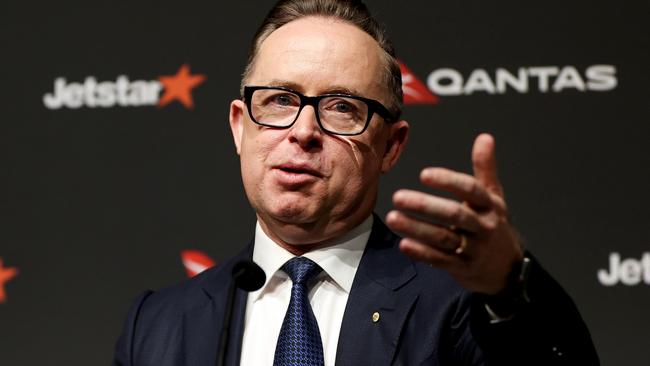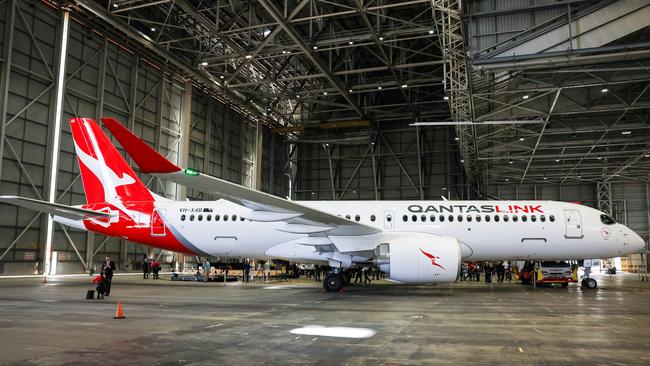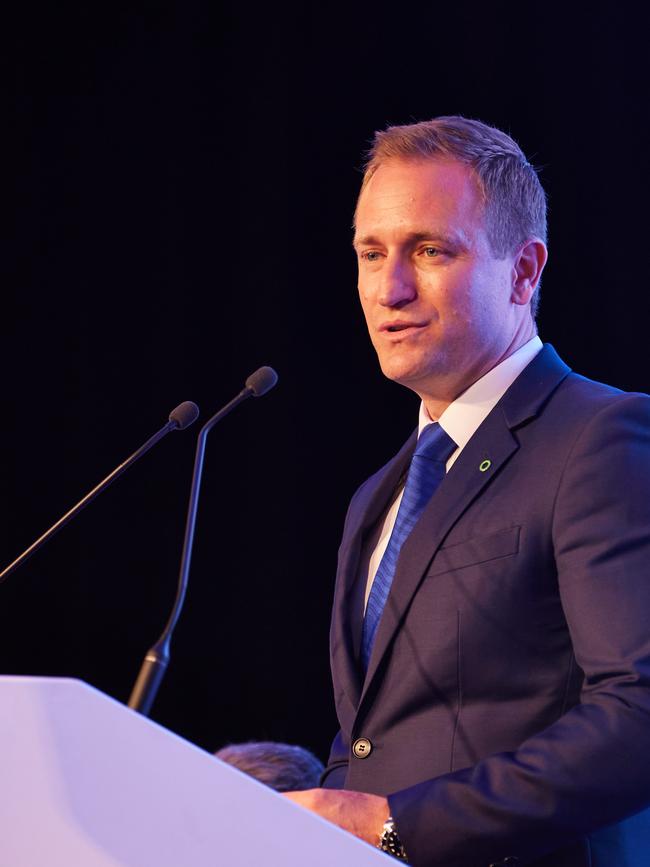
To ram home how things have changed, Hudson took her first earnings briefing out of Joyce’s long-preferred bunker at the Mascot headquarters and into the hangar down the road to show a Qantas is taking shape.

Hudson was visibly proud showing off a brand new A220, part of a massive order of new aircraft to pump up domestic and international capacity, and make for a smoother travel experience.
The cutting-edge A220 that Hudson was standing under can fly to anywhere in Australia, it is flexible enough to be allocated into peak demand or regional routes and it costs as much as 30 per cent less to operate – which is all good for the airline’s bottom line.
Hudson says that over the past six months she has spent more time listening than talking. Much of this has been with frontline staff but she’s also sat in on customer focus groups.
“I’m surrounding myself with detractors, not promoters, because it’s in that voice of the customer that makes you absolutely focused on where you need to drive better outcomes,” the airline’s former chief financial officer says.
Hudson has a monitor above her desk back at Mascot showing how long customers are being put on hold inside the call centres.
To drive it home, Hudson has overhauled and stripped back the airline’s core vision statement: “It starts with our people and customers”.
Hudson knows she has a monumental job ahead rebuilding Qantas’ battered reputation.
As well as a trust game, it is also going to come at big financial cost.
In the past six months alone she has spent nearly $100m on the customer experience, including improving food, technology and Wi-Fi, and helping customers track luggage.
And there is more to come, with another $130m to be spent over coming months. Right now her priority is to tackle persistent cancellations and delays – the biggest bugbear of passengers.
Although there is a zero target for delays, Hudson concedes she can’t fix them all as weather, airport congestion and unwavering priority on safety puts some delays beyond her control.
It was telling that Hudson spent her first results briefing talking up her staff more than the numbers.
Indeed frontline workers, engineers, pilots and cabin crew were invited along to hear the session and watch the new CEO face the questions.
Hudson later said her leadership approach “is about involving our people”.
The choice of the hangar as a venue was to show the new aircraft was about the customer story.
“There’s no more impact than having the aircraft right behind you,” she tells The Australian. “It makes an enormous difference to understanding the value that we are bringing through our investments”.
‘Customers first’
All this is a big change following Joyce’s take-no-prisoners approach to running the airline where profit and investors put above all else.
This assault on customers and staff worked in a world where aviation was running full capacity. And investors rode the benefits all the way while Qantas showered them with cash. Joyce too held tight on his investment in the fleet, sweating his older planes longer, which in part is forcing Qantas to play catch-up on its fleet renewal today. Eight new aircraft landed in recent months and nearly 60 in the next two years.
However Joyce’s management model unravelled spectacularly when Qantas was trying to restart its business coming out of the Covid pandemic. An ACCC legal action into alleged ghost flights (Qantas is contesting the allegations) ultimately forced Joyce out early and chairman Richard Goyder to bring forward his planned exit.

This week former Telstra chair and known corporate peacemaker John Mullen was named as the new chairman. While two more directors, Maxine Brenner and Jacqueline Hey, stood down on Thursday as more collateral damage from the Joyce era.
Even so, Joyce, who was still boss for two of the six months the December half results covered, has delivered the financial platform allowing Hudson to reinvest in Qantas.
December half net profit of $869m was down 13 per cent, but beat market expectations of $800m. Margins were squeezed as ticket prices came off but remain healthy in parts. Qantas’ preferred measure sees the airline posting a pre-tax profit of $1.2bn.
Nor were investors totally forgotten on Thursday after Qantas topped up its ongoing share buyback by another $400m. The clouded outlook and doubts about near term earnings targets wasn’t enough prop up the shares that were already highly-priced going into the result. Qantas shares sunk 6.8 per cent by late in the session.
The airline is still nursing accumulated losses that have prevented the payment of dividends, but Husdon reckons this could be chewed up and dividends resume as early as next financial year.
For customers, tickets prices are slowly coming down – falling 10 per cent through the December half – as more capacity comes into the market, although that’s hurting earnings margins. And while demand for travel remains robust, it’s nothing like the immediate post-Covid days. Overall costs are rising, as the airline too cranks up to full capacity but unit costs are actually dropping as the airline becomes more efficient by running normally.
Hudson resisted kitchen-sinking the numbers with writedowns and even with the focus on customers she committed her new executive team to series of earnings targets set down by Joyce before his rushed exit. However, Hudson later conceded the timing for the delivery of some could be pushed back into next financial year with a softer demand for business travel, broader inflation pressures and unexpected weakness in freight demand. As Joyce’s former finance boss, Hudson has some ownership of the targets that cover domestic, international and Jetstar brands.

As more of the new lower-cost aircraft are added to the fleet, this will underpin earnings over the long run. “The performance of these aircraft are going to be transformative,” she says.
While profits are resilient for now, Joyce has still left plenty of bumpy air pockets for Hudson. The biggest is the looming ACCC legal action against alleged sales of tickets to ghost flights continues through the courts. The airline has opened the door for a settlement. If this can’t be struck the case is expected to begin later this year and a loss for Qantas would be a sizeable financial hit as well the prospect of a court hearing reliving the reputational blows.
In coming months a Federal Court too will consider the compensation figure for hundreds of baggage handlers sacked when they were stood down during the Covid-19 groundings. This follows a serious of negotiations she personally held with unions on compensation but talks failed. Hudson says she was disappointed by the outcome and believed Qantas put a “fair and reasonable offer” on the table.
It’s going to be a balancing act for Hudson to get it all right. It will be even tougher for the new CEO to play nice to everyone at once if the aviation market again turns negative. For now though, Hudson is determined to get her new Qantas out of the hangar and ready to fly.
Fortescue’s core business fires
With all the twists and green energy headlines of the past two years it’s easy to forget Andrew Forrest’s Fortescue has an iron ore business. And in the market where other metals have been weighing down results of bigger rivals, Fortescue has bucked the trend by delivering better-than-expected 41 per cent lift in December half profit to $US3.33bn ($5.05bn) and a sweetener on the dividend to a bumper $1.08 a share. New boss Dino Otranto says his job is to put operational consistency around the mining business. Indeed Speaking from Gabon in Central Africa where Fortescue is looking to develop a new iron ore mine, Otranto describes his aim as “consistent progress and innovation”. Fortescue posted the second highest first half shipments on record as the new high-grade Iron Bridge mine ramps up.

The chief executive says AI is now being used help plan train movements across the Pilbara, helping Fortescue to get back on track after a derailment late last year. Indeed the miner posted record ships. Still it’s the energy side that is front of mind with the promise of delivering 15 million tonnes of green hydrogen by the end of the decade. There was a promise of a flurry of projects to help get there, but three have only made it to final investment decision stage. Energy boss Mark Hutchinson, also in Gabon, says “There’s still a great pipeline” of green hydrogen projects to come but the early ones should be seen as a learning experience about the electrolyser technology, Hutchinson says.
Elsewhere, the base metals and coal major Glencore is pushing through the pain in nickel prices. While bigger rival BHP is a step away from putting its Nickel West operations on care and maintenance and took a massive financial hit on the business, Glencore left its Murrin Murrin nickel mine in Western Australia untouched and operational. The mine is supported by cobalt output, and even as prices here have softened as well it gives Murrin Murrin strategic importance. The West Australian mine given it is the only key supply of cobalt, a key battery ingredient outside of the central African country of DR Congo.

However Glencore chief Gary Nagle confirmed he was putting the loss-making New Caledonia nickel venture on care and maintenance for six months and was looking to sell his 49 per cent stake.
“Yes, the nickel business is a little bit challenged at the moment, but given the geography and the cost structure of our nickel business being in Australia and Canada, there’s a good future for our nickel business,” Nagle told analysts.
Glencore, which is also one of the word’s biggest coal miners, is feeling the brunt of base metals price hit and coal pullback. Underlying earnings for last calendar year fell 61 per cent to $US10.4bn.
johnstone@theaustralian.com.au







Alan Joyce’s fingerprints might have still been on Qantas’ latest profit numbers but the airline’s new chief, Vanessa Hudson, is going to great lengths to show the carrier is taking a different flight path.